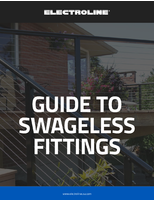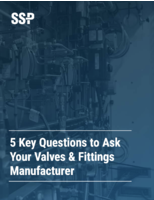Super Torquer Reduces Machined Clutch System Component Costs by 65 Percent Utilizing Four Kurt HD Vises -- Setup with Quick Change Jaws Hold 40 Components for Highest Density Machining
Little Falls, Minnesota: Four Kurt HDM6 double station vises mounted side by side on a vertical milling machine (VMC) gave Super Torquer Systems, Inc. reduced part machining costs of 65 percent utilizing quick change jaws and some intuitive process planning by the company's owners, Randy and Cindy Nouis.
Randy and Cindy Nouis designed the clutch parts, which received a huge industry response requiring them to develop the manufacturing output to meet demand. Unique and high performance by design, the Heel Clicker kit has an exclusive dual quadrant flyweight design that transfers engine power into the highest horsepower output of any clutch kit currently on the market. "The Heel Clicker kit adds 20 percent more power to the average snowmobile," reports Randy Nouis, "and has become the clutch kit of choice by most leading snowmobile and ATV manufacturers."
As a new startup company, Super Torquer had to devise ways to manufacture and assemble their new clutch design in varying quantities to meet a range of vehicular sizes and applications. The clutch weights are used in snowmobiles built by Polaris, Arctic Cat, Yamaha, Kawasaki and Bombardier. Initially using nearby outside manufacturing sources, the husband and wife team (and only employees of the company) decided to develop their own precision machining capabilities to improve quality, reduce costs and control part inventory.
With strong work backgrounds in design and manufacturing (both Randy Nouis and Cindy Nouis are degreed mechanical engineers with over 14 years experience each with General Motors Corporation/Delphi Corporation), the two understood manufacturing processes. While short of hands-on machining experience, they were confident that they could develop a cost effective machining process which included a workholding setup and machine programming to easily handle the broad platform of clutch components for their customers. As it turned out, the machining process improved turnaround time, quality and profitability of the clutch product line.
"We knew we could improve our machined part quality and turnaround time if we had the right equipment," reported Randy and Cindy Nouis. "We settled on a new Hurco model VM1 vertical machining center and looked at various workholding options including standard vise products and custom fixturing. We contacted our local Kurt sales representative, Mike Neeley, for his workholding recommendations thinking custom fixturing would be the answer. As a more cost effective and flexible alternative, Neeley suggested Kurt's HD vises, which provide many of the benefits of custom workholding but are far less costly. With carvable and changeable jaw options, they are ideal for holding large and small irregularly shaped parts with high clamping rigidity, requirements for Super Torquer's products. After studying product prints, tolerance and quantity requirements, Kurt's engineers recommended equipping the machining center with four Kurt HDM6 vises with machinable ductile iron jaws."
The key clutch component for machining in this setup is called a continual variable transmission (CVT) flyweight or clutch cam arm. It is machined out of high carbon steel. The cam arm controls and distributes engine rpm into torque. A typical clutch arm measures 1 inch x 2 inch x 1/2 inch with contoured precision surfaces. Each cam arm has a tapped and threaded hole and is matched in trios and quads to one-tenth gram weight. Critical surface areas must meet ± .001 tolerances to function properly, a challenge to machine but not rocket science.
The initial justification for the recommended setup was that four Kurt HD twin station vises provided high density for holding 4 of the cam arms per vise. These vises also provided a flexible platform using machined changeable jaws for holding and machining other components in the clutch weight assemblies. That, plus the machined jaws are easily changed so machine downtime is minimal, part holding rigidity is excellent and repeatable accuracy is a given. As it turned out with the Nouis' creative process planning, many more benefits were achieved with this Kurt workholding setup, including holding 10 parts per vise instead of the projected 4 parts.
Maximizing All Of The Vise Clamping Station Real Estate
When the Nouis team started to plan the changeable jaw setup for the four vises, they saw an opportunity to really maximize on the productivity of the setup. Conventional wisdom would have individual cut blanks inserted into the carved vise jaw pockets for a sequence of machining operations. Sequentially, machined components would be removed, repositioned and reclamped individually in each adjacent vise, machining different part sides in all four vises in a series until parts were completed, eight per cycle and removed completed from the fourth vise. In a conventional sequence, unfinished blanks are inserted as finished ones are removed thus keeping all 32 clamping stations loaded and progressively moving through the machining process.
However, with the Nouis team, conventional wisdom doesn't apply and that's where the virtues of the multiple Kurt HD vise setup got even better. Instead of machining 32 individual cam arms in the four vises, they upped the number to 40. They accomplished this by using solid 2-½ in x 1-¼ in x ¾ in high carbon steel blanks, each blank yielding five finished parts. Jaws are designed with datum points so the blanks align exactly the same in each of the four vises insuring part repeatability. Working left to right, the blank is inserted in the farthest left vise with the jaws carved with pockets to accommodate it. Jaws in vises two, three and four also are custom carved to align and hold the semi-finished part as it progresses through the machining process.
Ninety-five percent of the machining for most of the cam arms is end milling on 3 sides with the remainder drilling, reaming and tapping with accuracy to .001 inch. A full cycle of 40 cam arms is completed in just under 20 minutes. Lot sizes average 3000
What's really clever about this approach is that the work blank remains a solid piece until the end of the machining cycle in the fourth vise. At that point, the five individual cam arms are cut apart and finish machined and removed from the vise.
Another clever aspect of this process is that adjacent cam arms are machined at one time by the same ½-inch end mill. Staggered and located closely together, the parts align in a tight pattern which allows simultaneous end milling on two parts. Much is accomplished doing it this way including machining at top speed of 10,000 rpm, minimizing spindle travel part to part, reducing individual part handling and load/unload operations while maximizing all machinable area on the components held in the vise jaws.
Kurt Vise Rigidity An Important Factor In Clamping Repeatability
Small and relatively narrow parts made of hard materials such as Super Torquer's high carbon steel held in conventional vise setups tend to creep upward during aggressive machining operations. Tight tolerance is lost and scrap parts result. Not so with Kurt's HD vises. The Anglock® jaws prevent parts from creeping up and misaligning. Also, the vise bodies and jaws are made of durable 80,000 PSI ductile iron which provides rugged strength, rigidity and long-term accuracy while absorbing machining vibration. Four of the vises (each13.750 inch x 6 inch) lock solidly to the Hurco 30 inch x 14 inch machine table above its rugged 6,200 lb solid frame and are integrated as a single, immovable unit. With clamping force up to 5556 lbs at 70 foot lbs of input torque, these vises provide repeatable accuracy to 0.0002 inch, well within the Nouis' tolerance requirements.
Credit Cindy Nouis For Creating The Innovative Machining Programs
As engineers, the Nouis team understood the capabilities of their machining center and its potential when equipped with the four Kurt HD vises. It was another matter getting it to operate the way they envisioned and that's where Cindy Nouis' previous computer skills and outside machine programming training made the difference.
"Basically, we were working on a clean sheet of paper, not having seen this done before," stated Cindy Nouis. "Also, it was new to Kurt and they urged us forward when they saw its potential. I read programming books, took classes and did some trial and error programming. We planned each clamping station in such a way that all sides of the vise jaws are carved to hold various size part configurations, thus maximizing the available clamping area of each vise jaw. The staggered part pattern also allowed us to machine five cam arms in each vise where originally there was space for only four. Once set, the part programs were reverse engineered for carving each of the jaw clamping stations. We carved the ductile iron jaws ourselves so nothing was lost in the translation."
Cindy Nouis is also the machine operator and enjoys seeing the results of her programming efforts, reports her husband. "We've reduced our machining costs by over 65 percent so this system should pay for itself three times over the first year," he said. "We're both very pleased with Kurt for their workholding ideas and encouragement to make a good workholding setup do more."
For information about Super Torquer capabilities, call
Randy and Cindy Nouis at 1-320-632-4749
Email: ntechnology@qwest.net
Fax: 1-320-632-4780
Write to Super Torquer Systems, Inc.
1006 6th Avenue NW
Little Falls, Minnesota 56345
Website: www.supertorquer.com
For information about Kurt workholding products
In USA and Canada
call 1-800-328-2565.
Outside USA and Canada
call 1-763-572-4424
Email: workholding@kurt.com
In USA, fax 1-877-226-7828
Outside USA, Fax 1-612-623-3902
Write to Kurt Manufacturing Company
Industrial Products Division
1325 Quincy Street NE
Minneapolis, Minnesota 55413
Website: www.kurtworkholding.com




